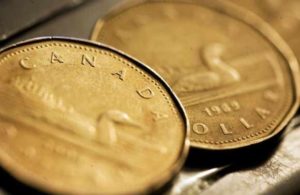 The loonie, as the Canadian dollar is best known, dropped for a second day against its US counterpart, after new home sales in the US rose to a five-yer high, fueling speculation Federal Reserve Chair Janet Yellen will back stimulus taper in her testimony before the Senate tomorrow.
The loonie, as the Canadian dollar is best known, dropped for a second day against its US counterpart, after new home sales in the US rose to a five-yer high, fueling speculation Federal Reserve Chair Janet Yellen will back stimulus taper in her testimony before the Senate tomorrow.
USD/CAD touched a session high at 1.1117 at 15:01 GMT, after which consolidation followed at 1.1096, adding 0.1% for the day. Support was likely to be found at February 25th low, 1.1055, while resistance was to be encountered at February 24th high, 1.1143.
Demand for the US dollar was supported after official data revealed that for all of 2013, demand for US homes surged by 16.3% to reach a five-year high of 428 000.
The US Census Bureau reported today that nations new home sales rose by 9.6% to reach annualized level of 0.468 million in January, confounding analysts expectations for a 1% drop to 0.400 million. At the same time, Decembers reading was revised upwards to 0.427 million units from previously estimated 0.414 million units. The current housing market conditions seemed to improve as Januarys reading was the strongest since June 2013, easing concerns over the US economic outlook.
Federal Reserve Chair Janet Yellen is expected to take a statement on Thursday, while investors await the central bank’s view on the economic impact of severe weather. Yellen said earlier in February that US economy has gained enough strength in order to withstand reduction of monetary stimulus.
“Any data or any Fed speakers going forward that reiterate the Fed’s tapering is dollar-positive,” Omer Esiner, chief market analyst in Washington at the currency brokerage Commonwealth Foreign Exchange Inc., said in a Bloomberg interview. “Investors are really concerned about how weak economic data may influence the outlook for monetary policies.”
The Federal Reserve announced in December that it will pare monthly bond-buying purchases by $10 billion, after which it decided on another reduction of the same size at the meeting on policy in January, underscoring that labor market indicators, which “were mixed but on balance showed further improvement”, while nation’s economic growth has “picked up in recent quarters.”
The central bank will probably continue to pare stimulus by $10 billion at each policy meeting before exiting the program in December, according to a Bloomberg News survey of 41 economists, conducted on January 10th.
Meanwhile, the loonie received some support last week after official data showed the nation’s inflation rate accelerated at a 1.5% annualized rate in January, which is the highest pace in 1-1/2 years amid surge in home heating costs.
However, demand for the Canadian dollar was pressured after a report showed the nation’s retail sales registered the largest one-month decline in a year. Retail sales declined 1.8% to 40.2 billion Canadian dollars or $36 billion in December, while analysts predicted a 0.4% drop. In November, retail sales increased by 0.5%.
In addition, Statistics Canada reported on February 19 that wholesale sales declined 1.4% to 49.6 billion Canadian dollars ($45.3 billion) in December, in comparison with a 0.4% decrease estimated by experts. November’s reading received downward revision to a 0.2% drop.
The eastern parts of Canada were hit by a severe ice storm in December, which caused power outages and left thousands of homes in Ontario, Quebec and the Atlantic provinces without electricity.
According to Bank of Montreal chief economist Doug Porter, cited by Bloomberg, the Canadian gross domestic product probably shrank in December because of the storm.
The Canadian economy is struggling to recover from an almost two-year slowdown and the latest reported data did show that the economy grew at an annualized 2.7% pace in the third quarter. However, economists surveyed by Bloomberg News predict that growth slowed to 2.5% in the fourth quarter, ahead of Statistics Canada quarterly GDP report, scheduled to be released on Friday, February 28th.
Elsewhere, GBP/USD hit a session high at 1.6701 at 09:30 GMT, after which consolidation followed at 1.6695, adding 0.08% for the day. Support was likely to be received at February 25th low, 1.6643, while resistance was to be met at February 25th high, 1.6727. On February 17th, GBP/USD touched 1.6823, the strongest level since November 2009.





